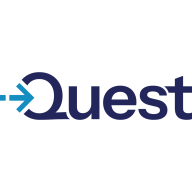

AWS Elastic Disaster Recovery and NetVault Plus compete in the domain of disaster recovery solutions. AWS seems to have an upper hand with its seamless integration within cloud environments and a cost-effective pay-as-you-go model, while NetVault offers comprehensive backup functionalities and user flexibility.
Features: AWS stands out with instant block replication, automated orchestration, and integration with AWS services, making it ideal for complex environments. It focuses on managed services, reducing the need for infrastructure management. NetVault is recognized for its efficient backup and restore capabilities, efficient catalog management, and support for various database types, offering customizable backup searches to meet diverse user needs.
Room for Improvement: AWS users cite the need for better automation and logging. Concerns include license costs and the need for more detailed monitoring logs. NetVault could improve its restore functionality, interface design, and scheduling flexibility. There is a call for stronger reporting formats and enhanced command-line abilities, with users seeking better processing speed and backup performance.
Ease of Deployment and Customer Service: AWS excels in cloud environments with seamless AWS service integration, driving its suitability for public and hybrid cloud deployments. It is known for proactive technical support and responsive customer service at the enterprise level. NetVault is favored for on-premises and private cloud setups, boasting solid customer support, though lacking a formal ticketing system. User experience differs based on infrastructure preferences.
Pricing and ROI: AWS Elastic Disaster Recovery is seen as expensive but offers substantial ROI due to service integration reducing infrastructure costs. Its flexible pay-as-you-go pricing can lead to accumulating storage and data transfer costs. NetVault provides tailored licensing, allowing scalability to specific requirements, potentially lowering upfront costs. While NetVault's component licensing offers affordability and flexibility, AWS's comprehensive services and pricing might be more appealing for long-term cloud-based strategies.
However, with AWS Elastic Disaster Recovery Service being a native service, integration is seamless, highlighting the return on investment.
In case of any issue, they are ready to provide support within the defined SLA timeline.
I would rate Quest support as eight.
The response time is good, but resolving some issues can take time due to dependencies on external devices.
Quest NetVault Plus is highly scalable, rated at an eight.
It is very good and very reliable.
AWS is not difficult, but the cost associated with replicating data to another region can be significant.
There have been very few issues reported in the past year, with only one ticket raised, indicating its reliability.
This would detail user activity directly in the ACL console for easier debugging and auditing.
In AWS Disaster Recovery Service, these details are not available, making it difficult to check my replication status.
There is also a need for better security measures, as security is critical to ensure backups are safe and free from malware.
Improvements should come, particularly in compatibility, backup performance, or better troubleshooting.
NetVault Plus doesn't have a support team in my country; having a local contact in Turkey would be very useful for us.
The pricing is not expensive, rated around a four in terms of cost.
AWS Elastic Disaster Recovery Service is a native service, integration is seamless.
Quest NetVault Plus supports a wide range of databases such as MSSQL, MySQL, Oracle, and SAP, offering extensive coverage.
The application supports scanning files for malware before backup operations.
The backup and recovery capabilities of NetVault Plus are very important for maintaining my business.
| Product | Market Share (%) |
|---|---|
| AWS Elastic Disaster Recovery | 1.7% |
| NetVault Plus | 1.2% |
| Other | 97.1% |


| Company Size | Count |
|---|---|
| Small Business | 5 |
| Midsize Enterprise | 4 |
| Large Enterprise | 7 |
| Company Size | Count |
|---|---|
| Small Business | 7 |
| Midsize Enterprise | 1 |
| Large Enterprise | 6 |
CloudEndure Disaster Recovery enables real-time replication and rapid recovery to enhance organizational resilience. Key features include block-level data replication, ease of use, cost-effectiveness, and automated recovery orchestration. Users benefit from increased efficiency, improved workflows, and enhanced data management, significantly improving organizational performance and business continuity.
NetVault Plus is a dependable backup and recovery solution that efficiently manages and protects data across multiple environments, supporting scalable operations through user-friendly features and extensive compatibility with databases and virtual systems.
NetVault Plus offers a comprehensive approach to data backup and recovery, suitable for large-scale implementations across various industries. With capabilities in snapshot-based backup, swift recovery, and malware scanning, it ensures stable operations. The platform supports numerous databases and virtual machines, providing network access control and timely email updates on job statuses. Users benefit from its straightforward recovery processes and the ability to create backup jobs and tape server restoration. Though improvements are needed in web interface speed, pricing transparency, restore accuracy, and compatibility with newer technologies like MongoDB and Microsoft updates, it remains a significant tool for robust data protection.
What are the core features of NetVault Plus?In specialized industries like pharmacy and retail, NetVault Plus enhances client data management and security log processes, leveraging application snapshotting to protect virtual environments such as Nutanix Xi. It provides robust protection and backup solutions tailored to diverse server versions, including Oracle, SQL, and bare metal recovery scenarios.
We monitor all Disaster Recovery (DR) Software reviews to prevent fraudulent reviews and keep review quality high. We do not post reviews by company employees or direct competitors. We validate each review for authenticity via cross-reference with LinkedIn, and personal follow-up with the reviewer when necessary.